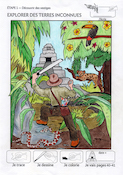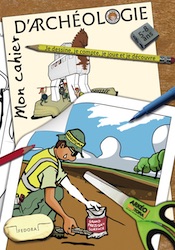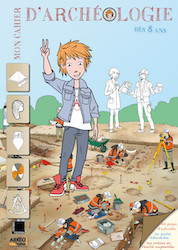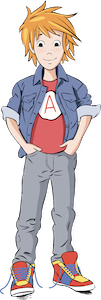Finding Archaeological Remains by Chance
- Last Updated: Tuesday, 28 June 2022 09:36
- Published: Thursday, 03 March 2022 14:02
- Written by Jean-Olivier Gransard-Desmond translated by Chloé Walot and Leah Gallet
- Hits: 1615
Join Augustin, Alex, Lisa and the whole ArkeoTopia team to discover additional resources for step 1 in My Archaeology Book about exploration and the accidental discovery of new civilizations.
Step 1. Discovering Archaeological Remains
Exploring Uncharted Territories
or How accidental discoveries are made
Corresponding pages in MAB1 and MAB2
MAB 1, p. 6 (step 1.3 of page 6 in the 1st edition) and MAB 2, pp. 6-7.
More about this step’s reference artifact
 The drawing in My Archaeology Book titled Exploring Uncharted Territories was inspired by Tikal Temple I, located in the Tikal National Park of Northern Guatemala’s Petén province. This step illustrates the concept of an accidental discovery. This kind of discovery is not based on a scientific approach, but is rather a matter of luck. For this reason, there is not an archaeologist pictured in the drawing, but instead an explorer named Gaspard.
The drawing in My Archaeology Book titled Exploring Uncharted Territories was inspired by Tikal Temple I, located in the Tikal National Park of Northern Guatemala’s Petén province. This step illustrates the concept of an accidental discovery. This kind of discovery is not based on a scientific approach, but is rather a matter of luck. For this reason, there is not an archaeologist pictured in the drawing, but instead an explorer named Gaspard.
Registered on UNESCO’s World Heritage List since 1979, Tikal was one of the largest urban centers of the pre-Columbian Mayan civilization. The city includes thousands of architectural and artistic remains dating from the Preclassic period (600 BCE) up through the city’s decline and eventual fall around 900 CE. The various ecosystems and habitats surrounding the city are home to a diverse neotropical fauna, including jaguars, which is what Clio, the female jaguar, represents in the book.
Tikal was a major pre-Columbian political, economic, and military center and is one of the most important archaeological sites of the Mayan civilization. The primary monuments are located within an inner urban zone with an area of around 988 acres. This zone includes palaces, temples, ceremonial platforms, small and medium-sized residences, ball-game courts, terraces, roads, and large and small public squares. Among these, Temple I, located along the western edge of the Great Plaza, is a landmark emblematic of Tikal’s architectural style.
Often called the “Temple of Ah Cacao” or the “Temple of the great Jaguar”, Temple I was built around 734 CE. Standing atop the base of a pyramid with nine stepped levels and surmounted by a roof comb, the temple rises to a lofty height of 47 meters. A single flight staircase leads to the temple proper, which consists of three small successive rooms. Above each door is a wood lintel made of several pieces of sapodilla. This mortuary temple, completed around 740-750 CE and dedicated to Jasaw Chan K'Awil, one of the greatest k'uhul ajaw (meaning holy lord) of Tikal, who was buried inside the structure around 734 CE. His tomb was discovered underneath the pyramid in 1962 by Aubrey Trik of the University of Pennsylvania.
Clues
The 10 clues include:
- The dense tropical vegetation
- The temple of Tikal
- Gaspard, the explorer
- The map
- The compass
- The machete
- The gun
- Narco, the snake
- Toccata, the toucan
- Clio, the female jaguar
Clues 4-7 indicate the difficult nature of finding this hidden temple. The drawing illustrates an archaeological discovery made by accident - an accidental or inadvertent discovery - made possible by an adventurer that explores regions that are difficult to access.
 |
 |
|
My Archaeology Book 1 |
My Archaeology Book 2 |

 My Archaeology Book, or MAB, is an activity workbook that combines creativity, fun and learning. Alongside young Augustin, a curious and courageous boy, children meet Alex and Lisa, two friendly archaeologists who will lead them to discover archaeology and French heritage. Each drawing illustrates a situation that Alex and Lisa might encounter at work. Depending on the age of the child and the workbook, children follow easy-to-understand symbols in order to experiment with activities such as coloring, drawing, observation games, riddles and reading in order to see the world through an archaeologist’s eyes. Alone, with family, at school or just for fun, children expand their knowledge and gain skills, all while having fun.
My Archaeology Book, or MAB, is an activity workbook that combines creativity, fun and learning. Alongside young Augustin, a curious and courageous boy, children meet Alex and Lisa, two friendly archaeologists who will lead them to discover archaeology and French heritage. Each drawing illustrates a situation that Alex and Lisa might encounter at work. Depending on the age of the child and the workbook, children follow easy-to-understand symbols in order to experiment with activities such as coloring, drawing, observation games, riddles and reading in order to see the world through an archaeologist’s eyes. Alone, with family, at school or just for fun, children expand their knowledge and gain skills, all while having fun.
On this section, you will find additional resources: color photos of archaeological documents that inspired My Archaeology Book, additional teaching documents (flip-book, websites, suggestions for classroom use, edutainement, etc.) and information on upcoming publications. Each page will be updated over time.







